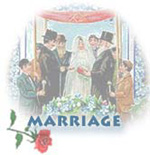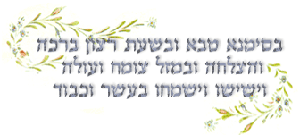|


In Judaism, marriage is
celebrated both as a joyous event and a sacred act. The Hebrew word used for
the wedding is kiddushin, which comes from the verb le-kadesh,
"to make holy." Furthermore, in traditional ceremonies, as the groom
places the ring on the bride's finger he states, "Behold you are consecrated
to me with this ring according to the Law of Moses and Israel." While today
it is common for the couple to exchange rings, it was traditional only for the
groom to give the bride a ring. Some unusual examples from Italy of gold with
filigree and enamel work are fashioned with a small structure on top, which
may symbolize the home the couple will share or perhaps the Temple.
 A
myriad of diverse customs are observed in different communities for all of the
events surrounding the engagement and wedding. In communities like Yemen and
Morocco, the brides wore highly elaborate gowns and jewelry and the ritual of
dressing of the bride was taken very seriously. Other localized customs have
to do with the gifts given to the bride and groom and the couple to one another,
such as marriage belts and silver book covers. Despite these differences, however,
there are certain integral elements which are common to all Jewish weddings.
The wedding takes place under a huppah, a canopy, which represents the
home that the couple will share. The huppah may be a tallit, or it may
be a specially made textile. During the course of the ceremony, after the appropriate
blessings are recited, the bride and groom each take a sip of wine from the
same cup. A
myriad of diverse customs are observed in different communities for all of the
events surrounding the engagement and wedding. In communities like Yemen and
Morocco, the brides wore highly elaborate gowns and jewelry and the ritual of
dressing of the bride was taken very seriously. Other localized customs have
to do with the gifts given to the bride and groom and the couple to one another,
such as marriage belts and silver book covers. Despite these differences, however,
there are certain integral elements which are common to all Jewish weddings.
The wedding takes place under a huppah, a canopy, which represents the
home that the couple will share. The huppah may be a tallit, or it may
be a specially made textile. During the course of the ceremony, after the appropriate
blessings are recited, the bride and groom each take a sip of wine from the
same cup.
Since two blessings are
recited, sometimes double cups fitted together in a barrel shape were used.
A special wedding goblet made in Breslau in 1752 is engraved with an inscription,
"The voice of the bridegroom, and the voice of the bride" (Jeremiah
33 : 11). Each couple has a ketubbah (marriage contract), which is in
fact a legal document originating in talmudic times as a financial guarantee
for the bride and stipulates the groom's other obligations to his wife as well.
As when it was first instituted, the text of the ketubbah is still written in
Aramaic. The standard text as we know it today was established in the Middle
Ages in the Ashkenazi communities of central and western Europe. The minor variations
found in the contracts give insight into some of the differences in customs
among communities. Only in recent years has there been some attempt to modernize
the text and make the ketubbah more egalitarian.
 The
tradition of illustrating ketubbot is known from fragments in the Cairo
genizah to have existed in Eretz Yisrael and Egypt as early as the tenth
to twelfth centuries. From medieval Europe there is only one extant illuminated
ketubbah from the Austrian city of Krems. The groom presents the bride
with a symbolically large ring. Originating in Spain before the expulsion in
1492, the illumination of ketubbot reached its apogee among the Sephardim
in Italy in the seventeenth and eighteenth centuries. The
tradition of illustrating ketubbot is known from fragments in the Cairo
genizah to have existed in Eretz Yisrael and Egypt as early as the tenth
to twelfth centuries. From medieval Europe there is only one extant illuminated
ketubbah from the Austrian city of Krems. The groom presents the bride
with a symbolically large ring. Originating in Spain before the expulsion in
1492, the illumination of ketubbot reached its apogee among the Sephardim
in Italy in the seventeenth and eighteenth centuries.
Much about societal differences
can be learned from these contracts because each has the date and place of the
wedding and the names of the bride and groom. Furthermore, because each ketubbah
is individually commissioned, the design and special conditions, including the
size of the dowry, provide insight into both the patron's status and artistic
sensibilities. Illuminated on parchment, many of the Italian ketubbah include
decorative programs with such components as biblical scenes, representations
of Jerusalem and symbols of the Temple, family emblems, zodiac signs, and a
variety of flora and fauna. A ketubbah from Padua dated 1732 is a rich compendium
incorporating all of these elements. Architectural references, mythological
figures, and elaborately interlaced knots are borrowed from non-Jewish art;
indeed, it seems that many of the artisans who illustrated the ketubbot
were not Jewish but were working with the specifications of the commissioning
family. A characteristic of ketubbah decoration in Rome in the late eighteenth
and early nineteenth century was the use of such allegorical personifications
as peace, fortune, goodness, and marital harmony. These reflect the contemporary
ideals of marriage; the images are borrowed from Christian tradition. An 1816
ketubbah from Rome also represents the practice of including illustrations which
refer to the names of the couple. In this instance, the groom's name was Elijah
and the scene of the prophet ascending to heaven in a fiery chariot is depicted
on the cusped edge of the parchment.
The practice
of illustrating ketubbot was also popular in the Sephardi communities
of western Europe, the western Ottoman Empire, and North Africa. A very elaborate
ketubbah from Hamburg dated 1690 portrays the actual wedding scene. The
bride and groom, flanked by their parents, stand under the huppah, which
is not free-standing but attached canopy-like to the wall. The officiating rabbis
stand in front of them. In attendance is a large group of guests, all quite
fashionably dressed, the men wearing elaborate wigs. An Istanbul ketubbah
dated 1853 includes a lovely cityscape scene along the shore within an elaborate
framework of rhythmic floral patterns. Jews living in the Islamic world also
made ketubbot. One from San'a, Yemen, dated 1794, is unusual for the
region in that it includes the figures of the bridal party, albeit very primitively
rendered. There are ketubbot from India and the Far East with interesting motifs,
emphasizing exotic birds and animals and local flowers. Unfortunately, as printed
contracts became the norm in the late nineteenth century, the art of ketubbah
illumination declined. Since the 1970s, however, there has been a renaissance
of hand-illuminated ketubbot.

The wedding culminates with
the breaking of a glass by the groom. In medieval Ashkenazi synagogues , there
was a special stone, called a traustein, embedded in the north wall of
the synagogue at which the glass was hurled. While the custom likely originated
from folk beliefs that the glass-shattering would ward off evil spirits, it
was interpreted by the rabbis as a reminder that even in times of greatest joy,
we recall the destruction of Jerusalem. The ceremony is followed by a wedding
feast, including music and dancing and often the reciting of special poems dedicated
to the bride and groom.
 |
 From:
Jewish Art, by: Grace Cohen Grossman. 1995, Hugh Lauter Levin Associates,
inc. (p. 128-129). From:
Jewish Art, by: Grace Cohen Grossman. 1995, Hugh Lauter Levin Associates,
inc. (p. 128-129).
|
MARRIAGE
Table of Contents
|



